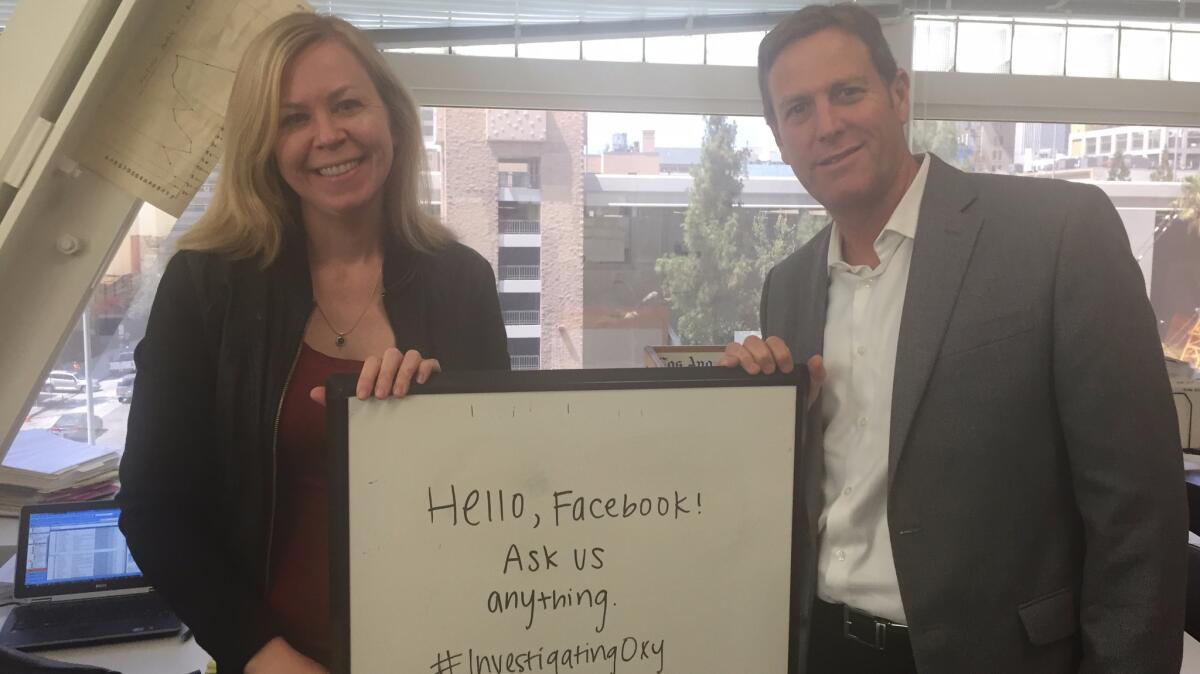The best of our Facebook Q&A on our second OxyContin investigation

We’re back with the second part of our investigation into OxyContin. Only this time, we reported on dirty doctors, shady prescriptions and an illegal L.A. drug ring that pumped more than a million OxyContin pills onto the black market — and how the pharmaceutical company watched it unfold.
A Los Angeles Times investigation found that, for more than a decade, Purdue collected extensive evidence suggesting that OxyContin was ending up in the hands of addicts and drug traffickers and, in many cases, did not share it with law enforcement or cut off the flow of pills.
We hosted a live Q&A on Facebook with reporters Harriet Ryan and Matt Lait. Here’s a roundup, edited lightly for clarity and length:
“Is Oxy still a thing? I thought everyone figured out heroin was much cheaper … and much better?”
Harriet: I think what you are referring to is the reformulation of OxyContin in 2010. Purdue Pharma changed the pill in August of that year so it was harder to crush for snorting, smoking or injecting. And many people who were addicted to OxyContin switched to heroin when they could no longer abuse Oxy by snorting, injecting or smoking.
But OxyContin is still abused. According to the FDA, the most common way to abuse OxyContin is by swallowing it and obviously the reformulation of the pill doesn’t prevent a person from abusing it by swallowing.
I was looking through Twitter Sunday for mentions of our story and I came across a tweet that had the word OxyContin in it. It was a list of painkillers, including Roxi 30s and Oxy 80s, and an email to contact a person who it seemed was selling those drugs.
“I can’t believe this is happening. ... How long has this been going on?”
Matt: With regard to the problems at Lake Medical records show that Purdue was aware of potential mis-prescribing in late 2008. The company eventually concluded the clinic was working with a corrupt pharmacy. It wasn’t until years later, when the drug ring had been dismantled and the ringleaders charged, that Purdue came forward to authorities to share the evidence it had collected.
“How could this clinic or so-called clinic operate without someone catching on with the state or federal level?”
Matt: Eventually authorities did catch on, arresting the ringleaders and charging them with federal crimes. It appears that Purdue knew about the problem before law enforcement and didn’t immediately alert them.
“Don’t they have prescription tracking in California? In New York, all prescriptions must be electronically filed. You must also show government ID just to buy over the counter drugs like Sudafed.”
Matt: California does have a prescription tracking program. It’s called CURES. It chiefly is aimed at helping doctors identify “doctor shopping” patients--those who are seeking drugs from multiple physicians. Many anti-abuse advocates have called for the database to be used also as a law enforcement tool to identify rogue doctors and pharmacies. Traditionally, the state’s database has been underfunded and law enforcement hasn’t relied on it mis-prescribing and drug trafficking.
“How culpable are doctors in the opioid epidemic?”
Harriet: Great question, Gabby. The CDC has called the prescription opioid epidemic a doctor-driven crisis. The agency’s new guidelines for physicians, released in March, discourage doctors for using painkillers like OxyContin to treat chronic pain. The CDC experts wrote that the risks of these drugs in wide, long-term use just outweigh the medical benefits. Which are unproven.
And when it comes to criminal trafficking of prescription drugs, the stories we published Sunday show how doctors can be used by drug rings to help dealers obtain enormous amounts of drugs for illicit use. Drug dealers can have the criminal network, guns, whatever, but they need a doctor with a prescription pad to make the ring work.
“Is Oxycontin on any ‘controlled drug’ list? If so, isn’t there a maximum that can be prescribed at a time and filled by a pharmacy?”
Harriet: OxyContin is a controlled substance under federal law. It is a schedule 2 narcotic. I am not aware of any legal caps on the amount of a drug a doctor can prescribe or a pharmacy can fill.
That said, under federal law, pharmaceutical companies are required to report suspicious orders to the DEA and the agency tells them that they cannot fill a suspicious order until they have validated as legitimate medically.
“What surprised you most in the course of your research on Oxycontin/Big Pharma?”
Matt: I suppose one of the things that surprised me most was the level of detail Purdue Pharma collected on OxyContin sales from the wholesaler and pharmacies distributing its drugs. It was also interesting to see in the internal documents how active sales representative were in identifying suspicious doctors and pharmacies.
“As a disabled person with 2 auto-immune diseases, I cannot get pain management doctors to prescribe this for me. Its one of the few things that work for my chronic pain. … Where do people like myself go from here?”
Harriet: I hear concerns like yours from readers frequently. Chronic pain is a big problem in this country and a terrible struggle for those who suffer from it. Our investigation of OxyContin and its maker doesn’t question that the drug provides relief for many patients with legitimate medical needs. Good luck to you.
Editor’s note: We moved this from Reddit to Facebook. Thanks for joining!
Tell us your story: Do you have an experience with OxyContin, or do you know someone who has?
UPDATES:
July 12: We updated this with a summary of our Facebook Q&A.
This article was originally published on July 10.



